Does 790FX + SB750 = High-End Overclocking?
Asus M3A79-T Deluxe
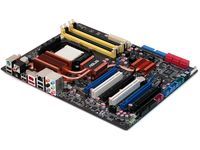
If the M3A79-T Deluxe looks familiar, it’s probably because the layout is nearly identical to that of its predecessor, the M3A32-MVP Deluxe. It would have been possible for Asus to use the same circuit board since AMD’s SB750 southbridge is pin-compatible with the earlier SB600 version, but we did notice that the USB header in the upper rear corner has fewer pins than the earlier WiFi mini-card-enabled version. A few smaller devices have also been moved around, but without altering the position of major components.
It appears that Asus even used the earlier product’s heat pipe assembly on this improved version, but without the additional memory cooler. Threaded bolt holes for attaching the device are still found on the northbridge sink.

The heat pipe assembly still provides passive cooling to 10 voltage regulator phases, supporting the high-wattage needs of overclocked quad-core Phenoms. Asus divides its power phases as eight for core processing and two for the processor’s integrated memory controller, allowing separate voltage changes within BIOS.
Layout remains solid overall, with power and SATA connectors within easy reach of top-mounted power supplies and bottom-mounted hard drive cages. That’s not to say everything is perfect, since long cables will be needed to reach SATA optical drives in the upper bay of tower cases. Also, the hard drive cage of certain case designs will block access to the forward-facing SATA ports—a problem that builders must remember when choosing components.
Forgivable shortcomings include an Ultra ATA connector located below the motherboard’s center line but which is still on the front edge and a floppy header near the rear of the motherboard beneath the lowest expansion slot. Associated devices are rarely used in new builds, so we aren’t too worried about them.
One thing that might prove particularly frustrating to high-end gaming system builders is that the bottom two PCI-Express 2.0 slots are only one space apart. This eliminates the possibility of two double-thickness cards such as the HD 4870 being used in both slots, in effect limiting CrossFireX configurations to a maximum of three high-end or four mid-range cards.
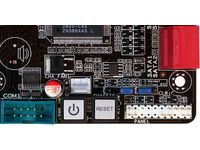
The M3A79-T Deluxe’s revamped circuit board now includes power and reset buttons near the front of the bottom edge. This addition forced Asus to move several smaller features, such as the removable BIOS IC and communications port, to alternative locations.
Stay on the Cutting Edge
Join the experts who read Tom's Hardware for the inside track on enthusiast PC tech news — and have for over 25 years. We'll send breaking news and in-depth reviews of CPUs, GPUs, AI, maker hardware and more straight to your inbox.
Onboard Devices
| Northbridge | AMD 790FX |
| Southbridge | AMD SB750 |
| Voltage Regulator | Ten Phases |
| BIOS | 0403 (09/16/2008) |
| 200.0 MHz (HT 2000) | 200.7 MHz (+0.35%) |
| Clock Generator | ICS 9LPRS477CKL |
| Connectors and Interfaces | Row 6 - Cell 1 |
| Onboard | 4x PCIe 2.0 x16 (Modes: Two x16 or Four x8) |
| Row 8 - Cell 0 | 2x PCI 2.2 |
| Row 9 - Cell 0 | 3x USB 2.0 (2 ports per connector) |
| Row 10 - Cell 0 | 1x IEEE-1394 FireWire |
| Row 11 - Cell 0 | 1x Serial Port Header |
| Row 12 - Cell 0 | 1x Floppy |
| Row 13 - Cell 0 | 1x Ultra ATA (2 drives) |
| Row 14 - Cell 0 | 6x Serial ATA 3.0Gb/s |
| Row 15 - Cell 0 | 1x Front Panel Audio |
| Row 16 - Cell 0 | 1x CD-Audio In |
| Row 17 - Cell 0 | 1x Fan 4 pins (CPU) |
| Row 18 - Cell 0 | 3x Fan 3 pins (Chassis/Power) |
| Row 19 - Cell 0 | 1x Internal Power Button |
| Row 20 - Cell 0 | 1x Internal Reset Button |
| IO panel | 1x PS2 (keyboard or mouse ) |
| Row 22 - Cell 0 | 6x USB 2.0 |
| Row 23 - Cell 0 | 2x Digital Audio Out (S/P-DIF optical + coaxial) |
| Row 24 - Cell 0 | 1x IEEE-1394 FireWire |
| Row 25 - Cell 0 | 1x External SATA |
| Row 26 - Cell 0 | 1x RJ-45 Network |
| Row 27 - Cell 0 | 6x Analog Audio (7.1 Channel + Mic-In + Line-In) |
| Mass Storage Controllers | Row 28 - Cell 1 |
| AMD SB750 | 1x Ultra ATA-133 (2-drives) |
| 6x SATA 3.0Gb/s (RAID 0,1,5,10) | |
| Marvell 88SE6111-NAA1 PCI-E | 1x External SATA 3.0Gb/s |
| Network | Row 32 - Cell 1 |
| 2x Marvell 88E8056-NNC1 PCI-E | Gigabit LAN Connection |
| Audio | Row 34 - Cell 1 |
| ADI AD2000B HD Audio Codec | Eight-Channel (7.1 Surround) Output |
| FireWire | Row 36 - Cell 1 |
| LSI L-FW3227-100 PCI | 2x IEEE-1394a (400 Mbit/s) |
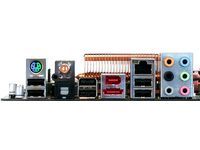
Asus targets the mid-priced gaming crowd by increasing support for mid-range graphics cards and eliminating a few unused features. Buyers won’t find Asus’ Draft-N wireless card or a second Gigabit network controller, as many would rather not pay for these two rarely used features. However, Asus does include the multimedia-centric FireWire controller.
Also missing is any internal connection for the eSATA controller. This could be important to some buyers, since so many bay devices now support a single front-panel port.
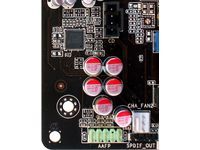
Asus has only provided a single PS/2 device on most of its motherboards for a few product cycles, but has recently improved the port’s compatibility to include keyboards and mice. Other ports are typical for an upper-to-mid-range product, including six USB 2.0 ports, coaxial and optical digital audio connectors, IEEE-1394 FireWire, and eSATA.
Asus doesn’t list as many features for the M3A79-T Deluxe’s AD2000B codec as it did for the AD2000BX of some higher-priced models, but buyers still get a few extras such as multi-streaming of separate audio sources and virtual surround sound.

Unfortunately, the motherboard’s front-audio cable header is located just about as far as it can be from the front-panel jacks of typical cases, and “everybody’s doing it” isn’t a good-enough excuse for putting this important connector in the lower-rear corner.
With its added-in SATA controller providing only one rear-panel eSATA port, it made sense for Asus to put the Marvell 88SE6111 on the motherboard’s rear edge, just below the 88E8056 Gigabit network controller.
FireWire isn’t needed by most gamers, but is probably one of the least-expensive added features Asus could use to boost the apparent value of its product. A PCI interface has more than enough bandwidth for two 400-megabit ports.
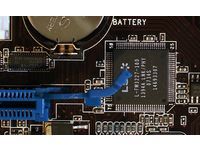
Current page: Asus M3A79-T Deluxe
Prev Page Introduction Next Page M3A79-T Deluxe Software, BIOS, and Accessories-
neiroatopelcc "Also notice the removable BIOS IC, a feature that makes bad-flash recovery as easy as plugging in a replacement."Reply
I don't know about you guys, but I haven't had a flash going wrong since a P2B board from the stoneage -
cangelini neiroatopelcc"Also notice the removable BIOS IC, a feature that makes bad-flash recovery as easy as plugging in a replacement."I don't know about you guys, but I haven't had a flash going wrong since a P2B board from the stoneageReply
Call it paranoia from a guy who changes BIOSs on an almost daily-basis on one board or another (me, not Thomas, though he does his fair share of updating, too).
-
neiroatopelcc Perhaps it's just the luxury of gigabyte's dual bios that makes me not care for removable ic's but I just don't see the relevance. Nobody has an eprom writer for those chips at home anyway, and with prices of many motherboards closing in on what a new chip would cost it's only truely useful for the expensive boards - and if an amd board is expensive, then it's targetted at the wrong people.Reply -
slomo4sho Thanks for the review. As you have stated, only way that AMD can compete with INTEL is to provide better clock speeds on their chips. Intel has shot forward with giant improvements and AMD has been stuck on the side lines. Their 45nm chips are still not on the market and Intel is already making moves to switch to 32nm.Reply
Sadly, this is going to be tough hill to climb for AMD to become competitive again. I wish them luck though, the consumer is always the winner when corporations compete :) -
Tropoc Im sorry, but this is rubbish:Reply
Ive got a phenom x4 9950 placed on a ASUS m3a32 mvp deluxe motherboard.
With stock voltage and stock cooling ive cranked it up to 3.2ghz and it runs perfectly stable. (this was done by only adjusting the multiplier)
A friend of mine have the same setup as me but an aftermarket cooler (noctua nh-u12p) and hes overclocked it up to 3.4ghz, again running stable.
On Overclocking forums i read about people cranking this CPU up to 3.6ghz on air (noctua nh-u12p) without any wizardry.
This test is flawed and im very dissapointed about tomshardware and what i feel is an effortless test of this setup.
Im an Intel guy myself but at least im honest about intels oponents, and in this case the review should end up with AMD being amazing value for money and that the future is a bit (not alot) brighter for AMD. -
slomo4sho You realize that the Q6600 can also be overclocked to 3.6GHz on air as well without much difficulty? Both processors are at the same price point. The only difference is that the 9950 is AMD's top end chip and the Q6600 is a entry level quad core from Intel...Reply
-
Tropoc im aware of that yes, but the problem here is tomshardware not the q6600... why? they didnt get it over 3.12ghz, which frankly is pathetic.Reply
and the 9950 is cheaper then the q6600 its cheaper then about every intel processor out there (even the dual cores such as e8400 etc).
Im not saying it is a better processor then what intel has lined up, what im saying is that it is amazing value for money. and much better at overclocking then tomshardware managed to get out of it thats all :D -
marzzes Oh my God, you guys went with a Jetway over a DFI board! Not to mention just one vidio card and a mid range one at that, how about two 4870X2’s??.. I mean isn’t that what we buy these boards for?…….Oh and what kind of memory each board can handle or why didn’t you go with a Thermalright cpu cooler, hell if your going to oc water cooling is the way to go!Reply
Obviously Tom wasn’t interested in doing this review!……..
-
geckoar I got my 9950 running at 2.85 ghz so thir numbers are not too bad. Im running it on a 790FX+SB600 K9A2 mobo. I could go more but my DDR2 800 RAm is holdinmg me back... I guess I should have gotten DDR2 1066 RAM.Reply
But I game at 1080P res. wiht a 4870 and I get over 30FPS in most of my games At max setting.
Good Review.
Most Popular


